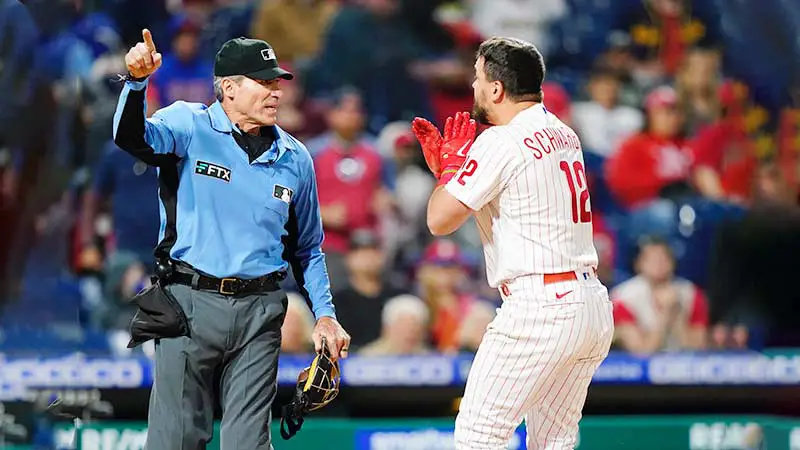Ever wondered why baseball umpires are often called “blue”? This nickname has puzzled many, but its origins are deeply rooted in the sport’s history.
The term “blue” isn’t just a whimsical moniker; it’s a nod to the traditional uniforms that umpires have worn for decades.
In the early days of baseball, umpires were easily recognizable by their blue uniforms, which set them apart from the players on the field.
This distinct color choice made it easier for players and fans to identify the officials, leading to the affectionate nickname, “blue.” Even as umpire uniforms have evolved, the name has stuck, becoming a beloved part of baseball vernacular.
Historical Origins of the Nickname “Blue”
The nickname “Blue” has historical origins rooted in various cultural and linguistic contexts:
Early References in Baseball History
The nickname “Blue” has uncertain origins, with theories suggesting links to various historical and cultural elements. Some theories propose connections to Puritan blue laws, symbols of authority, or Civil War associations.
However, the most accepted theory ties the term to the traditional blue uniforms worn by umpires in the late 19th century.
These uniforms distinguished the umpires from players and underscored their role as impartial enforcers of the game’s rules.
The Role of Umpire Uniforms
Initially, umpires wore formal attire, including suits and ties. By the late 19th century, they adopted blue woolen uniforms similar to those worn by police officers.
This blue uniform not only reinforced their authority on the field but also helped differentiate them visually from the players.
Despite modern changes in uniforms, the concept of “Blue” remains. The Major League Umpires Association has ensured that blue continues to be a symbolic color, representing the long-standing tradition and respect for the umpire’s role in baseball.
Umpire uniforms have evolved to be more functional, featuring elements like steel toes and larger pockets for carrying additional baseballs, yet the legacy of the blue uniform endures.
The Significance of the Color Blue
The color blue holds significant cultural, symbolic, and psychological meanings across various contexts:
Connotations of Authority and Neutrality
The color blue has strong ties to authority and neutrality. Throughout history, many law enforcement agencies have chosen blue uniforms.
This choice fosters an image of trust and reliability. Baseball leagues embraced this same concept with blue umpire uniforms.
Blue symbolizes authority, enhancing the perception that umpires are impartial enforcers of the game’s rules. This fosters respect among players and fans.
Psychological Impact on Players and Fans
Blue uniforms have a significant psychological impact on both players and fans. The color blue is associated with calmness and stability, which can help maintain order on the field.
When you see an umpire in blue, it evokes a sense of fairness and consistency. This perception contributes to a smoother gameplay experience.
Fans also associate blue uniforms with the long-standing traditions of baseball. This connection strengthens the historical and cultural ties to the sport.
The enduring legacy of umpire uniforms in blue underscores their symbolic significance in maintaining the integrity and fairness of the game.
Evolution of Umpire Uniforms in Baseball
The evolution of umpire uniforms in baseball reflects changes in style, technology, and practicality over time:
Transition from Suit to Sport-Specific Attire
Earlier, baseball umpires donned formal blue suits, symbolizing authority and impartiality. These suits included jackets with large pockets to carry new baseballs.
From 1906, enhancements like screw-in spiked plates and toe pads reduced field slippage. By the late 1930s, steel-toed shoes became standard. Eventually, uniforms adapted to include inside chest protectors, prompting larger jackets.
Over time, this distinctive blue attire became synonymous with the role, leading to the nickname “blue.” Even as modern umpire uniforms have evolved, retaining the iconic blue hue pays homage to the tradition.
Modern Umpire Apparel and Its Functions
Today’s umpire uniforms are designed for functionality and protection. Modern gear includes chest protectors, shin guards, and masks, safeguarding against errant balls.
Breathable fabric and moisture-wicking technology enhance comfort during games. Steel-toed shoes with improved grip ensure stability on various field surfaces.
Uniforms maintain the traditional blue hue, preserving the symbol of authority while integrating advanced features for safety and ease of movement.
The traditional blue color dates back to the early 20th century when umpires initially wore dark blue suits, making them easily recognizable on the field.
This iconic hue has endured, symbolizing the umpire’s critical role in maintaining fairness and order in the game.
While fashion and functionality have evolved, the blue remains a nod to the rich history and longstanding traditions of baseball, reinforcing the umpire’s authority and presence on the diamond.
“Blue” in Baseball Culture
In baseball culture, the term “Blue” holds several significant meanings and associations:
Representation in Media and Popular Culture
The term “Blue” has embedded itself deeply within media and popular culture. Movies, TV shows, and literature often depict baseball umpires clad in their iconic blue uniforms. This portrayal reinforces the umpire’s image as an authoritative and neutral figure on the field.
For example, in classic baseball films, the umpire’s blue uniform often symbolizes fairness and order. This visibility in media helps maintain the term’s resonance within and beyond the sport.
Impact on Baseball Vernacular
“Blue” has significantly influenced baseball vernacular. Players, coaches, and fans commonly address umpires with this term, often shouting phrases like “Come on, Blue!” during games to express opinions on calls.
Beyond direct interactions, the term has permeated discussions about baseball, becoming shorthand for authoritative decision-making.
The consistent use of “Blue” underscores the lasting legacy and cultural significance of umpire uniforms in the sport.
Comparative Perspective
In a comparative perspective across different sports and cultural contexts, the nickname “Blue” holds varied meanings and associations:
Nicknames for Umpires in Other Sports
While baseball umpires are colloquially known as “Blue,” different sports use various nicknames for their officials. In basketball, you call umpires “Refs.”
Basketball referees manage the game’s flow, making crucial calls to maintain fairness. Football uses the term “Official,” a title that underscores their authority in enforcing rules and making judgments on the field.
In soccer, “Referee” is the universal term, reflecting its global standards. Cricket umpires, often called “Umps” or “Umpires,” hold a respected position for their role in rule enforcement within a long-duration game context.
In rugby, “Ref” is commonly used, emphasizing the official’s function in overseeing the game and ensuring adherence to regulations.
These variations illustrate how different sports cultures shape the ways officials are regarded and referred to.
Global Variations in Umpire Terminology
Umpire terminology varies across different regions, reflecting diverse cultural and linguistic traditions. In the United States, the term “Blue” in baseball emphasizes authority and impartiality due to historical uniform color.
In contrast, European football sticks to “Referee,” adhering to international linguistic standards. In India, cricket enthusiasts use the term “Umpire,” respecting the game’s heritage and its British origins.
Similarly, rugby players worldwide call their officials “Ref,” derived from “Referee,” underscoring game management duties.
Basketball’s global reach has popularized “Ref,” a shorthand for referee, consistent across various countries regardless of language.
These distinctions highlight how regional and cultural contexts influence the terminology for sports officials, contributing to the rich tapestry of global sports language.
| Sport | Nickname | Origin | Cultural Significance | Historical Context |
|---|---|---|---|---|
| Baseball | Blue | Blue uniforms | Authority, tradition | Late 19th century |
| Basketball | Ref | Short for referee | Game management | Developed with sport |
| Football | Official | Authority | Rule enforcement | Evolved with sport |
| Soccer | Referee | Traditional term | Global standard | International standard |
| Cricket | Umpie | Informal term | Informal respect | Traditional term |
| Rugby | Ref | Short for referee | Game management | Developed with sport |
Frequently Asked Questions
Do umpires still wear blue today?
Yes, while modern umpire uniforms have evolved to include more sport-specific gear, the blue color remains a traditional and symbolic part of their attire.
Are umpires called “blue” in other sports?
No, the term “blue” is specific to baseball. Other sports have their own terms for officials, such as “refs” in basketball and “officials” in football.
What are some other nicknames for sports officials?
In addition to “blue” for baseball umpires, common nicknames for sports officials include “refs” in basketball and “officials” in football.
How do other countries refer to sports officials?
Terminology for sports officials varies globally based on regional and cultural contexts. For instance, in cricket, officials are called “umpires,” similar to baseball, while other sports may use different terms like “referees” or “judges,” highlighting the rich diversity in global sports terminology.
Conclusion
Understanding why baseball umpires are called “blue” offers a fascinating glimpse into the sport’s rich history and cultural significance.
The tradition of blue uniforms has evolved yet remained a symbol of authority and neutrality. This term, deeply rooted in media and popular culture, reinforces the umpire’s role as a fair enforcer.
Different sports and regions have their own unique terms for officials, reflecting diverse cultural contexts. This diversity in terminology enriches the global language of sports, highlighting the unique ways we perceive and honor those who uphold the rules.
In the case of baseball, the color blue became synonymous with umpires due to the standard navy blue uniforms they traditionally wore.
Over time, the nickname “blue” embedded itself into the lexicon of the game, serving as a universal moniker for these pivotal figures.
While modern umpires may don black or other colors, the legacy of “blue” endures, symbolizing their essential role in maintaining the integrity of the sport.








Pat Bloom